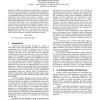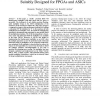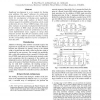39 search results - page 2 / 8 » A Low Power Approach to Floating Point Adder Design |
ISCAS
2005
IEEE
15 years 6 months ago
2005
IEEE
: Asynchronous circuits are often presented as a means of achieving low power operation. We investigate their suitability for low-energy applications, where long battery life and d...
110
click to vote
CDES
2006
15 years 2 months ago
2006
In this paper, a double precision IEEE 754 floating-point multiplier with high speed and low power is presented. The bottleneck of any double precision floatingpoint multiplier des...
115
click to vote
ISLPED
1997
ACM
15 years 4 months ago
1997
ACM
Significand pre-alignment is a pre requisite for floating point additions. This paper1 addresses the architectural design and energy delay evaluation of a Low Power Barrel Switch ...
CORR
2010
Springer
15 years 1 months ago
2010
Springer
In recent years, Reversible Logic is becoming more and more prominent technology having its applications in Low Power CMOS, Quantum Computing, Nanotechnology, and Optical Computin...
111
click to vote
ARITH
2009
IEEE
15 years 8 months ago
2009
IEEE
Moduli of the form 2n ± 1, which greatly simplify certain arithmetic operations in residue number systems (RNS), have been of longstanding interest. A steady stream of designs fo...



